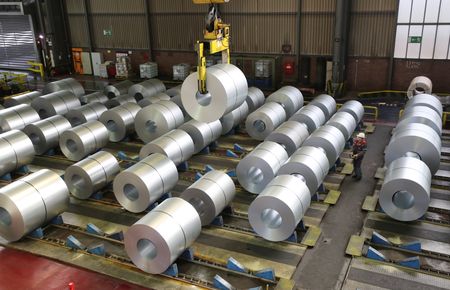
By Eric Onstad
LONDON (Reuters) – Surging European steel prices are set to extend their gains as Russia’s invasion of Ukraine has disrupted logistics, spurred sanctions and sent energy prices soaring.
Russia is the world’s fifth biggest steel producer, while Ukraine comes in at 14th. The two combined account for a fifth of imports to the European Union.
European hot rolled coil (HRC) prices have shot up by nearly 40% over the past three weeks. Prices in North America and China have also gained, but by much less, around 7-8%.
“It’s certainly looking like prices will continue to rise in the short term. We’re forecasting that prices will jump again by the end of this month and into April,” said analyst Kaye Ayub at consultancy MEPS International.
“The supply side has been massively disrupted in Europe, and that will take quite a while to resolve.”
Russia and Ukraine punch above their weight in the global steel market due to hefty exports, especially to Europe.
“In Europe, pricing power is clearly still with the steel mills… as the loss of about 20% of finished steel imports from Russia/Ukraine tightens the market,” UBS analyst Andrew Jones said in a note.
Even though Western nations have not specifically targeted Russian steel companies with sanctions, logistics problems and the knock-on impact of sanctions have disrupted businesses and shipments.
In addition to fears of losing supply from Russia and Ukraine, Europe is also having to contend with a surge in energy prices due to the conflict.
Its steel sector was already grappling with high energy costs when Russia’s invasion of Ukraine in late February spurred another spike in the price of oil and gas, driving electricity prices higher.
Electric furnaces for steelmaking account for just over 40% of Europe’s output, higher than in other regions.
After hostilities broke out, steelmakers in Spain such as ArcelorMittal and stainless steel producer Acerinox cut production, while Germany’s Lech-Stahlwerke stopped output in Bavaria.
The full impact of the conflict has not yet shown up in production data, but European steel output in January had already declined to the lowest level seasonally since 2009, according to Bank of America analyst Michael Widmer.
In February, crude steel output in the European Union fell 2.2% month-on-month and elsewhere in Europe dropped by 4.8%, data from the World Steel Association showed.
(Reporting by Eric Onstad; Editing by Jan Harvey)

